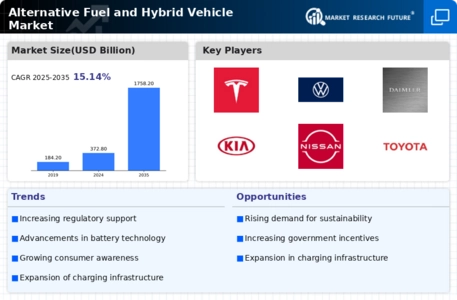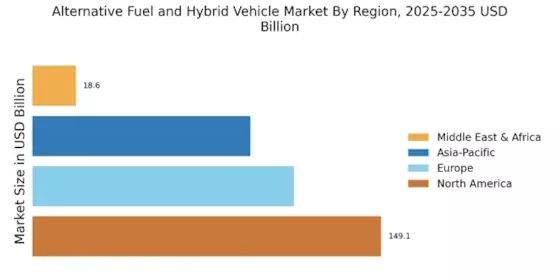Rising Fuel Prices
The Alternative Fuel and Hybrid Vehicle Market is experiencing a notable shift due to the rising prices of traditional fuels. As consumers face increasing costs at the pump, there is a growing inclination towards alternative fuel options that promise lower operational costs. In recent years, the price volatility of gasoline and diesel has prompted consumers to seek more economical solutions. This trend is further supported by the fact that hybrid vehicles often offer better fuel efficiency compared to their conventional counterparts. According to recent data, hybrid vehicles can achieve fuel economy ratings of up to 50 miles per gallon, which significantly reduces the overall cost of ownership. Consequently, the rising fuel prices are likely to drive demand for alternative fuel and hybrid vehicles, as consumers prioritize cost-effective transportation solutions.
Shifts in Consumer Preferences
Consumer preferences are evolving, and this shift is having a profound impact on the Alternative Fuel and Hybrid Vehicle Market. Increasing awareness of environmental issues and the desire for sustainable transportation options are driving consumers towards hybrid and alternative fuel vehicles. Surveys indicate that a significant percentage of consumers are willing to pay a premium for vehicles that offer lower emissions and better fuel efficiency. Furthermore, the rise of electric vehicle charging infrastructure is making it more convenient for consumers to consider alternative fuel options. As more individuals prioritize sustainability in their purchasing decisions, the demand for hybrid vehicles is expected to grow. This change in consumer behavior is likely to reshape the automotive landscape, pushing manufacturers to innovate and expand their offerings in the alternative fuel segment.
Increasing Environmental Regulations
The Alternative Fuel and Hybrid Vehicle Market is significantly influenced by the tightening of environmental regulations across various regions. Governments are implementing stricter emissions standards to combat climate change and reduce air pollution. For example, many countries have set ambitious targets to reduce greenhouse gas emissions, which has led to the promotion of alternative fuel vehicles. The introduction of regulations that incentivize the adoption of hybrid and electric vehicles is becoming more common. In some regions, manufacturers are required to meet specific emissions targets, which can only be achieved through the production of cleaner vehicles. This regulatory environment is likely to accelerate the transition towards alternative fuel and hybrid vehicles, as both consumers and manufacturers adapt to comply with these new standards.
Investment in Charging Infrastructure
Investment in charging infrastructure is a pivotal driver for the Alternative Fuel and Hybrid Vehicle Market. The expansion of charging networks is essential for the widespread adoption of electric and hybrid vehicles. Governments and private entities are increasingly recognizing the need for robust charging infrastructure to support the growing number of alternative fuel vehicles on the road. Recent reports indicate that the number of public charging stations has been steadily increasing, with projections suggesting a continued upward trend. This enhanced accessibility to charging facilities alleviates range anxiety among consumers, making hybrid and electric vehicles more appealing. As the infrastructure improves, it is likely to encourage more consumers to transition to alternative fuel vehicles, thereby propelling market growth.
Technological Innovations in Vehicle Design
Innovations in vehicle design are playing a crucial role in the Alternative Fuel and Hybrid Vehicle Market. Advances in aerodynamics, lightweight materials, and energy-efficient technologies are enhancing the performance and appeal of hybrid vehicles. For instance, manufacturers are increasingly utilizing advanced composite materials that reduce vehicle weight, thereby improving fuel efficiency. Additionally, the integration of smart technologies, such as regenerative braking systems, is becoming more prevalent. These innovations not only enhance the driving experience but also contribute to lower emissions, aligning with the growing consumer demand for environmentally friendly options. As a result, the continuous evolution of vehicle design is expected to bolster the market for alternative fuel and hybrid vehicles, attracting a broader consumer base.


















Leave a Comment